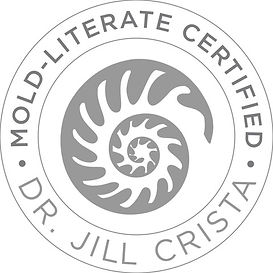HEALING FROM MOLD ILLNESS &
MYCOTOXIN EXPOSURE
It is estimated that 25-50% of buildings in America have significant mold growth. [1] This growth can cause symptoms ranging from sneezing, chronic sinusitis, chronic nasal drip, and migraines to life-threatening conditions.
These symptoms can manifest slowly (over a period of years), suddenly (upon entry to a building or room), or be delayed by hours or days - making it hard to pinpoint the source of symptoms.
Once there has been mold exposure, a person often becomes 'sensitized.' This causes an allergy-like reaction to things like dust, histamine, pet dander, old books, fragrances, and volatile organic compounds (VOC's).
This new hypersensitivity to environmental, chemical, and food allergens can be truly debilitating, and I have had patients who had previously moved across the country just to feel better.
Recently, I have also noticed an increase in patients suffering from a new mold sensitivity after having a Covid infection.
I have had success in mitigating or resolving even severe symptoms in my patients using functional medicine.
OVERLOOKED SYMPTOMS OF MOLD ILLNESS
-
Contrary Reactions to Medications, also called Paradoxical Reactions (ex., Anxiety medicine causes anxiety)
-
A Consistent Feeling of Ill-health (like always being on day two or three of the flu)
-
A New Sensitivity to Environmental Allergens After a Covid Infection
-
Histamine Intolerance
-
Highly Sensitive to Supplements and Medications
-
Chronic Sinus Congestion
-
Chronic Ear Congestion
-
Depression
-
Hives, Rashes
-
Shallow Breathing/Solar Plexus Tightness
-
Sneezing, Horseness, Coughing, Congestion
-
Panic Attacks, Anxiety
-
Insomnia
-
Seizures
-
Numbness, Tingling
-
Fainting
-
Blood Sugar Regulation Issues
-
Blood Pressure Regulation Issues
*SYMPTOMS CAN EXTEND FAR BEYOND THIS LIST. MOLD ILLNESS IS KNOWN TO CREATE A VERY WIDE RANGE OF SYMPTOM PRESENTATIONS.
The information in this article and on this website are intended for informational purposes only and does not take the place of seeing a doctor and should not be used for the purposes of diagnosis. If you are experiencing severe symptoms, have chest pain or trouble breathing, go to a hospital right away. Consult a doctor before beginning or stopping any medications or interventions.

THE HEALTH CONSEQUENCES OF MOLD EXPOSURE
Health consequences of mold exposure can be rapid onset or delayed (by hours or days) and could potentially last for years. Increased sensitivity to mold can happen after a new stress on the body (ex., after pregnancy, a move or an infection). It can also affect those in the form of low-grade inflammation, off and on, throughout their lives.
Mold inhalation while working, living, or visiting a mold-damaged building can cause neural, cognitive, and emotional dysfunction through innate immune activation (by increasing interleukin-1β immunoreactivity in the hippocampus). [2]
HEALTH CONSEQUENCES OF MOLD ILLNESS
-
Acquired Immune Activation [2]
-
Mood Changes [2]
-
Poorer Clinical Outcomes to Covid-19 [3]
-
Fatigue
-
Nausea
-
Headaches, Dizzyness [4]
-
Digestive Problems
-
Neurological Problems
-
Fever, Cough, and Flu-like Symptoms [5]
-
Increased likelihood of Asthma for Exposed Children [6]

SIMILARITIES AMONG PATIENTS WITH MOLD ILLNESS
As a doctor who has specialized in complex and chronic illnesses for more than a decade, mold illness fills in a diagnostic void that I have long noticed with my patients.
Most of my new patients have been suffering from symptoms for many years, and most of those do not fit into a neat diagnosis, but they often have many things in common.
The majority of my patients are 'sensitive' - they are highly reactive to medication and supplements and are very susceptible to emotional and physical stressors. Many of these patients have mold illness as an underlying reason for their sensitivity.
About 70% of these patients have chronic sinus congestion or infections, and almost all of my patients with mold illness have histamine intolerance.
This can manifest in bad reactions to foods that contain high amounts of histamine and foods that are 'histamine-releasing.' Even when patients don't know about histamine - they notice that they feel terrible when they eat fermented foods or foods containing vinegar.
Another trait that most mold illness patient share is that they don't think mold could possibly be the cause of their illness, and they are very reluctant to leave a mold environment.
It may be that mold exposure wears down your innate immune system so much that patients are simply too exhausted to contemplate a move or remediation easily.
There is also another important similarity that was noted by Dr. Jill Crista - that there is profound hopelessness and despair that patients experience with mold illness. With time and treatment, this is fixable.
UNDERLYING LIVER CONGESTION
Beneath mold illness lies an inability to process mold and mycotoxins fast enough. This burden is due to the fact that mold and mycotoxin exposure affects all three stages of liver detoxification - particularly the third stage, which requires adequate bile flow.
Poor bile flow and low stomach acid are two areas that we target early on in treatment.
Most patients with mold illness or who have had prolonged mold exposure have reported that doing a detox regimen or juice cleanse makes their symptoms much worse.
Targeted testing and tailored treatment are the way forward with mold illness.
FUNCTIONAL MEDICINE TREATMENT OF MOLD ALLERGY
The way I treat mold illness is a multi-stage process and is tailored to the individual. I do not do the same 'protocol' on every patient, and I do not have a set panel of testing that I do on everyone.
The purpose of functional medicine is to harness the latest testing capabilities and high-quality supplementation to restore your health.
At each follow-up appointment, the treatment is shifted to accommodate your improving health.
PHASE ONE: MOVEMENT
When you reach a level of mold exposure that results in symptoms, your body's ability to quickly filter out mold has been diminished.
Instead of a fresh flowing river, your body's detoxification pathways resemble a stagnant pond.
To restore balance, we need movement. This means movement of the digestive system and lymphatic system, the restoration of bile flow, as well as ensuring that you have enough stomach acid.
This initial stage also means a movement away from the mold source. As best you can, you should either move out of a water-damaged home or have it professionally remediated (never, ever attempt mold remediation yourself).
This often involves leaving furniture and belongings behind as they can easily become contaminated and bring spores into a clean environment.
The exact steps will vary from patient to patient, but in this stage, we focus on a restoration of your body's natural ability to get things moving again.
PHASE TWO: NERVOUS SYSTEM SUPPORT
When a person has dealt with mold illness for weeks, months, or years, it can be an incredible strain on the nervous system. These patients can feel like their nerves are fried and like they have no emotional or physical reserves.
In these cases, there are a few things that work almost universally and will be recommended in addition to your personal treatment plan.
The first is the practice of Spring Forest Qigong meditation. Unlike yoga and tai chi (which are extremely beneficial practices), this form of moving meditation was designed for those recovering from illness.
I practice it myself and notice that the patients who incorporate it tend to heal faster.
READ MORE ABOUT QIGONG HEALING
Next, we will find ways to optimize your sleep and tailor your diet for rapid healing.
PHASE THREE: PERSONALIZED REGIMEN
From this point on, your treatment will vary considerably from other patients. Your protocol will depend on your test results and your symptom presentation. If you have severe deficiencies, we will correct those.
If it turns out that you have multiple underlying conditions, then we will address your unique biochemical needs.
For patients with mold illness who are often extremely sensitive, it is vital to use carefully selected high-grade supplements that are tailored to a patient's needs.
Even a 'simple' vitamin deficiency needs to be remedied with care. The right form, at the right time, at the right dose often means the difference between relief and a bad reaction.
This is especially the case with B vitamin deficiencies (too often, the wrong form is given) and bile flow problems (most patients are highly sensitive to popular treatments).
Often those with mold illness have difficulty regulating their electrolyte balance due to the high demands of the nervous and adrenal system. Balancing this requires dietary changes and not just taking an electrolyte-replenishing drink (although a clean electrolyte formula can be helpful in the short term).
ONLINE CONSULTATION
Dr. Lum sees patients worldwide through online consultations, which can be conducted over the phone or on the computer. Dr. Lum is a Mold Literate Certified Practitioner through Dr. Jill Crista's certification program.
Unlike many clinics, you do not have to sign a contract for a certain amount of appointments per month, nor do you have to sign up for a 'plan.' You pay for each appointment as you have them.
We are now 100% online, and we are helping patients all over the world.
You can talk to Dr. Lum directly by scheduling a Free 15 Minute Consultation, or you can call or text the office directly at 816-728-5291.

Bibliography
[1] WHO Guidelines for Indoor Air Quality: Dampness and Mould. Geneva: World Health Organization; 2009.
.
[2] Harding, Cheryl F., Carolyn L. Pytte, Kimberly G. Page, Kelly J. Ryberg, Edna Normand, Gregory J. Remigio, Richard A. DeStefano, et al. 2020. “Mold Inhalation Causes Innate Immune Activation, Neural, Cognitive and Emotional Dysfunction.” Brain, Behavior, and Immunity 87: 218–28. https://doi.org/10.1016/j.bbi.2019.11.006.
[3] Benhadid-Brahmi Y, Hamane S, Soyer B, Mebazaa A, Alanio A, Chousterman B, Bretagne S, Dellière S. COVID-19-associated mixed mold infection: A case report of aspergillosis and mucormycosis and a literature review. J Mycol Med. 2022 Mar;32(1):101231. doi: 10.1016/j.mycmed.2021.101231. Epub 2021 Nov 26. PMID: 34864498; PMCID: PMC8620017.
[4] Delanoe, Antoine, Natacha Heutte, Stephanie Gente, Virginie Seguin, and David Garon. 2020. “Relationships Between Exposure to Bioaerosols, Moldy Surface and Symptoms in French Mold-Damaged Homes.” Atmosphere 11 (3): 223. https://doi.org/10.3390/atmos11030223.
[5] Delanoe, Antoine, Natacha Heutte, Stephanie Gente, Virginie Seguin, and David Garon. 2020. “Relationships Between Exposure to Bioaerosols, Moldy Surface and Symptoms in French Mold-Damaged Homes.” Atmosphere 11 (3): 223. https://doi.org/10.3390/atmos11030223.
[6] Tischer, C. G., C. Hohmann, E. Thiering, O. Herbarth, A. Müller, J. Henderson, R. Granell, et al. 2011. “Meta‐analysis of Mould and Dampness Exposure on Asthma and Allergy in Eight European Birth Cohorts: An ENRIECO Initiative.” Allergy (Copenhagen) 66 (12): 1570–79. https://doi.org/10.1111/j.1398-9995.2011.02712.x.






